Case Study: Ted's Biopsychosocial Colostomy Management
VerifiedAdded on 2022/07/28
|10
|2723
|40
Case Study
AI Summary
This case study analyzes Ted's colostomy surgery, addressing biopsychosocial factors, clinical reasoning, and nursing interventions. The study explores the impact of the surgery on Ted's life, considering religious and cultural implications. It examines the clinical reasoning cycle, focusing on information processing, problem identification, and outcome prediction. The assignment details nursing goals and interventions, including stoma care, dietary guidelines, and medication management (Neostigmine and Metoclopramide). The study emphasizes the importance of family education and patient support for holistic recovery. It also highlights potential complications and risk factors, such as diabetes and obesity, impacting Ted's post-operative rehabilitation and quality of life. The document emphasizes the critical need for comprehensive and tailored patient care to ensure optimal outcomes.
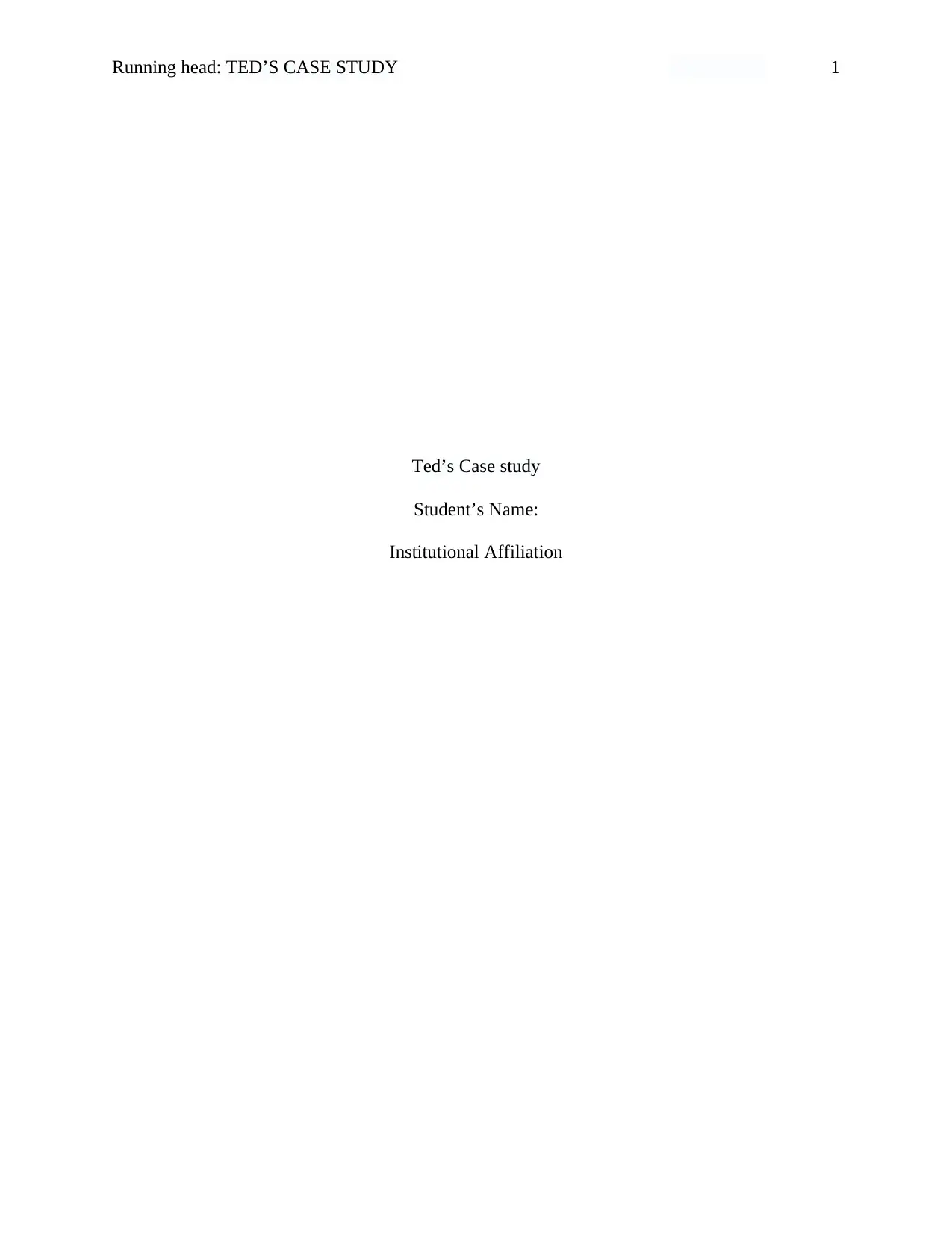
Running head: TED’S CASE STUDY 1
Ted’s Case study
Student’s Name:
Institutional Affiliation
Ted’s Case study
Student’s Name:
Institutional Affiliation
Paraphrase This Document
Need a fresh take? Get an instant paraphrase of this document with our AI Paraphraser
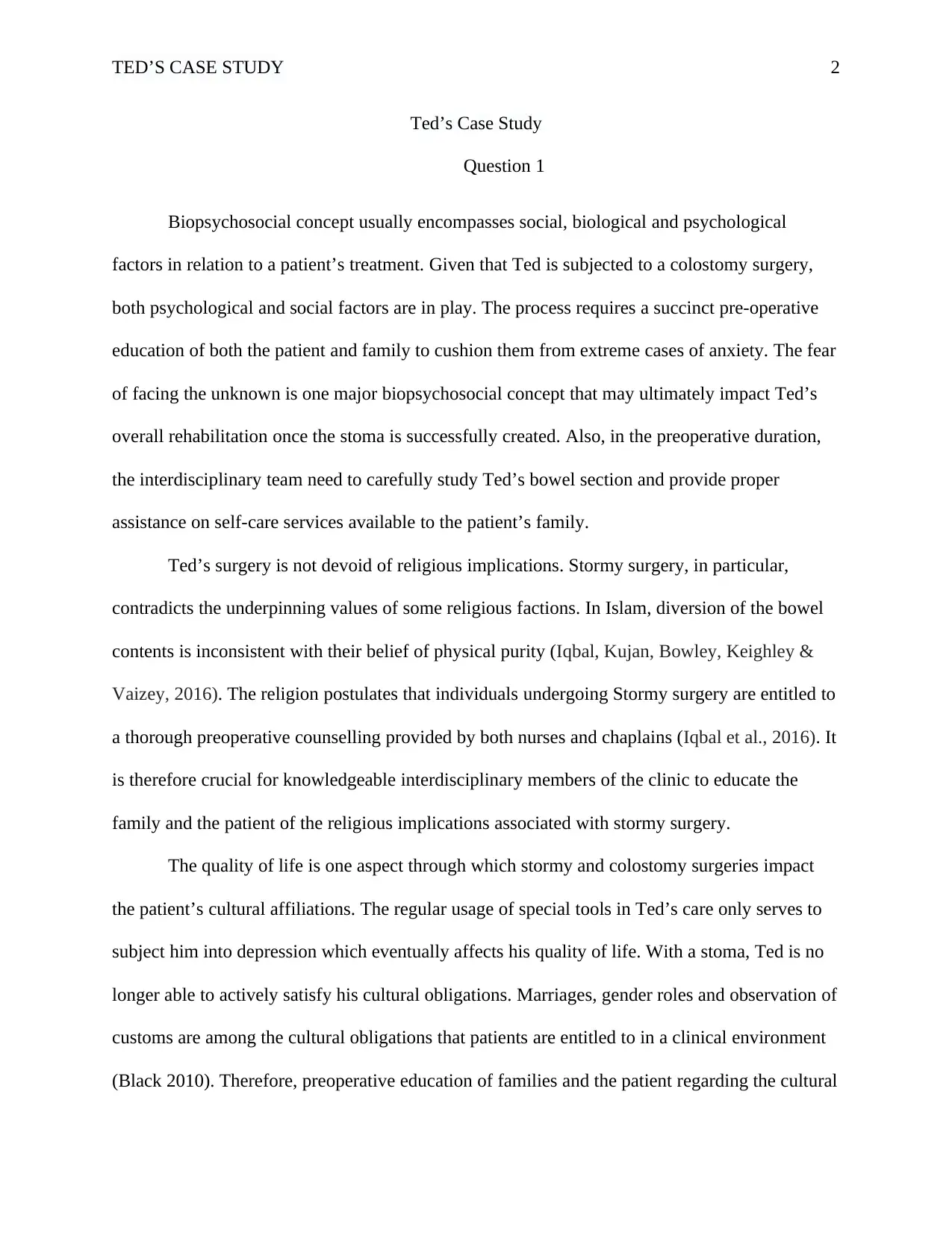
TED’S CASE STUDY
Ted’s Case Study
Question 1
Biopsychosocial concept usually encompasses social, biological and psychological
factors in relation to a patient’s treatment. Given that Ted is subjected to a colostomy surgery,
both psychological and social factors are in play. The process requires a succinct pre-operative
education of both the patient and family to cushion them from extreme cases of anxiety. The fear
of facing the unknown is one major biopsychosocial concept that may ultimately impact Ted’s
overall rehabilitation once the stoma is successfully created. Also, in the preoperative duration,
the interdisciplinary team need to carefully study Ted’s bowel section and provide proper
assistance on self-care services available to the patient’s family.
Ted’s surgery is not devoid of religious implications. Stormy surgery, in particular,
contradicts the underpinning values of some religious factions. In Islam, diversion of the bowel
contents is inconsistent with their belief of physical purity (Iqbal, Kujan, Bowley, Keighley &
Vaizey, 2016). The religion postulates that individuals undergoing Stormy surgery are entitled to
a thorough preoperative counselling provided by both nurses and chaplains (Iqbal et al., 2016). It
is therefore crucial for knowledgeable interdisciplinary members of the clinic to educate the
family and the patient of the religious implications associated with stormy surgery.
The quality of life is one aspect through which stormy and colostomy surgeries impact
the patient’s cultural affiliations. The regular usage of special tools in Ted’s care only serves to
subject him into depression which eventually affects his quality of life. With a stoma, Ted is no
longer able to actively satisfy his cultural obligations. Marriages, gender roles and observation of
customs are among the cultural obligations that patients are entitled to in a clinical environment
(Black 2010). Therefore, preoperative education of families and the patient regarding the cultural
2
Ted’s Case Study
Question 1
Biopsychosocial concept usually encompasses social, biological and psychological
factors in relation to a patient’s treatment. Given that Ted is subjected to a colostomy surgery,
both psychological and social factors are in play. The process requires a succinct pre-operative
education of both the patient and family to cushion them from extreme cases of anxiety. The fear
of facing the unknown is one major biopsychosocial concept that may ultimately impact Ted’s
overall rehabilitation once the stoma is successfully created. Also, in the preoperative duration,
the interdisciplinary team need to carefully study Ted’s bowel section and provide proper
assistance on self-care services available to the patient’s family.
Ted’s surgery is not devoid of religious implications. Stormy surgery, in particular,
contradicts the underpinning values of some religious factions. In Islam, diversion of the bowel
contents is inconsistent with their belief of physical purity (Iqbal, Kujan, Bowley, Keighley &
Vaizey, 2016). The religion postulates that individuals undergoing Stormy surgery are entitled to
a thorough preoperative counselling provided by both nurses and chaplains (Iqbal et al., 2016). It
is therefore crucial for knowledgeable interdisciplinary members of the clinic to educate the
family and the patient of the religious implications associated with stormy surgery.
The quality of life is one aspect through which stormy and colostomy surgeries impact
the patient’s cultural affiliations. The regular usage of special tools in Ted’s care only serves to
subject him into depression which eventually affects his quality of life. With a stoma, Ted is no
longer able to actively satisfy his cultural obligations. Marriages, gender roles and observation of
customs are among the cultural obligations that patients are entitled to in a clinical environment
(Black 2010). Therefore, preoperative education of families and the patient regarding the cultural
2
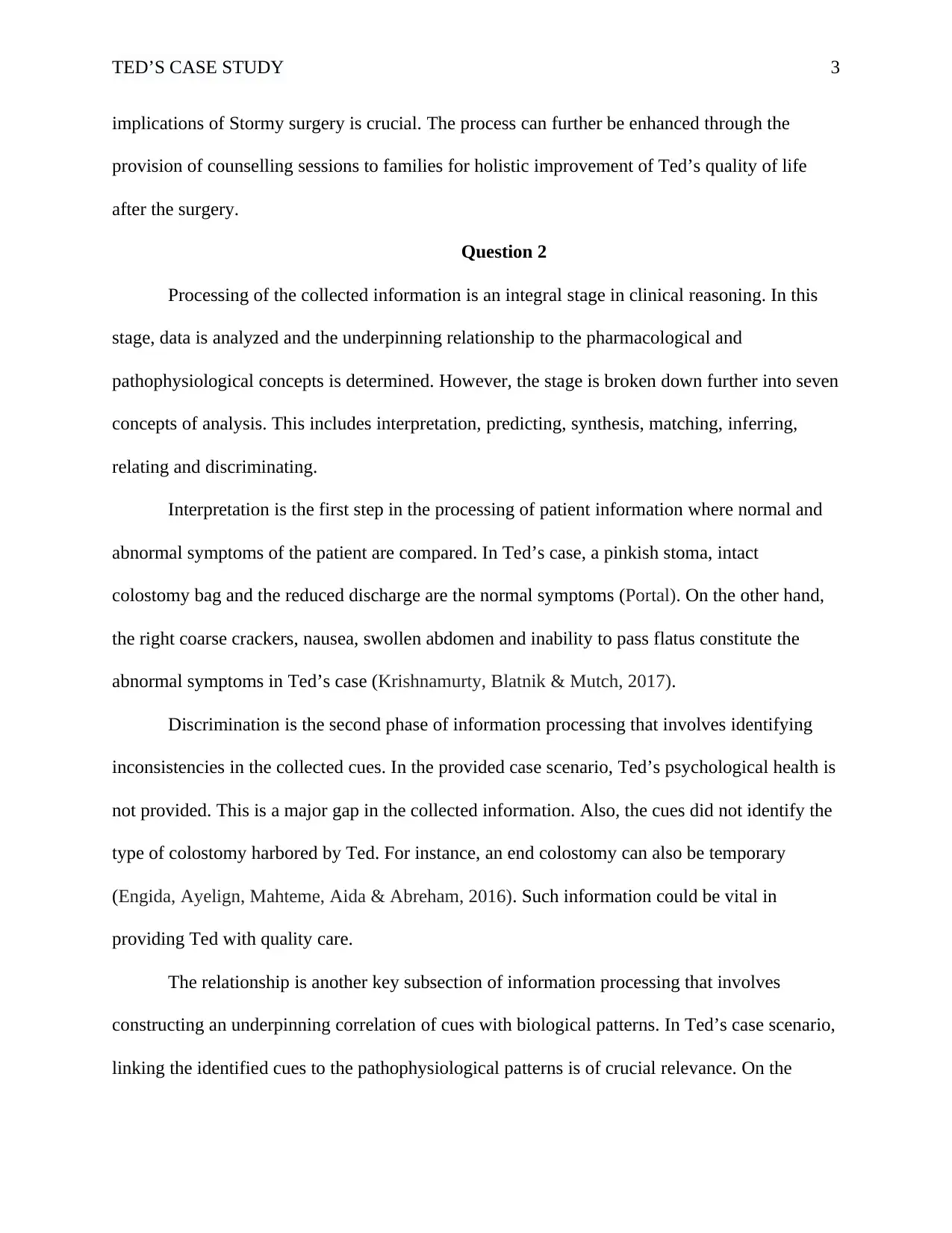
TED’S CASE STUDY
implications of Stormy surgery is crucial. The process can further be enhanced through the
provision of counselling sessions to families for holistic improvement of Ted’s quality of life
after the surgery.
Question 2
Processing of the collected information is an integral stage in clinical reasoning. In this
stage, data is analyzed and the underpinning relationship to the pharmacological and
pathophysiological concepts is determined. However, the stage is broken down further into seven
concepts of analysis. This includes interpretation, predicting, synthesis, matching, inferring,
relating and discriminating.
Interpretation is the first step in the processing of patient information where normal and
abnormal symptoms of the patient are compared. In Ted’s case, a pinkish stoma, intact
colostomy bag and the reduced discharge are the normal symptoms (Portal). On the other hand,
the right coarse crackers, nausea, swollen abdomen and inability to pass flatus constitute the
abnormal symptoms in Ted’s case (Krishnamurty, Blatnik & Mutch, 2017).
Discrimination is the second phase of information processing that involves identifying
inconsistencies in the collected cues. In the provided case scenario, Ted’s psychological health is
not provided. This is a major gap in the collected information. Also, the cues did not identify the
type of colostomy harbored by Ted. For instance, an end colostomy can also be temporary
(Engida, Ayelign, Mahteme, Aida & Abreham, 2016). Such information could be vital in
providing Ted with quality care.
The relationship is another key subsection of information processing that involves
constructing an underpinning correlation of cues with biological patterns. In Ted’s case scenario,
linking the identified cues to the pathophysiological patterns is of crucial relevance. On the
3
implications of Stormy surgery is crucial. The process can further be enhanced through the
provision of counselling sessions to families for holistic improvement of Ted’s quality of life
after the surgery.
Question 2
Processing of the collected information is an integral stage in clinical reasoning. In this
stage, data is analyzed and the underpinning relationship to the pharmacological and
pathophysiological concepts is determined. However, the stage is broken down further into seven
concepts of analysis. This includes interpretation, predicting, synthesis, matching, inferring,
relating and discriminating.
Interpretation is the first step in the processing of patient information where normal and
abnormal symptoms of the patient are compared. In Ted’s case, a pinkish stoma, intact
colostomy bag and the reduced discharge are the normal symptoms (Portal). On the other hand,
the right coarse crackers, nausea, swollen abdomen and inability to pass flatus constitute the
abnormal symptoms in Ted’s case (Krishnamurty, Blatnik & Mutch, 2017).
Discrimination is the second phase of information processing that involves identifying
inconsistencies in the collected cues. In the provided case scenario, Ted’s psychological health is
not provided. This is a major gap in the collected information. Also, the cues did not identify the
type of colostomy harbored by Ted. For instance, an end colostomy can also be temporary
(Engida, Ayelign, Mahteme, Aida & Abreham, 2016). Such information could be vital in
providing Ted with quality care.
The relationship is another key subsection of information processing that involves
constructing an underpinning correlation of cues with biological patterns. In Ted’s case scenario,
linking the identified cues to the pathophysiological patterns is of crucial relevance. On the
3
⊘ This is a preview!⊘
Do you want full access?
Subscribe today to unlock all pages.

Trusted by 1+ million students worldwide
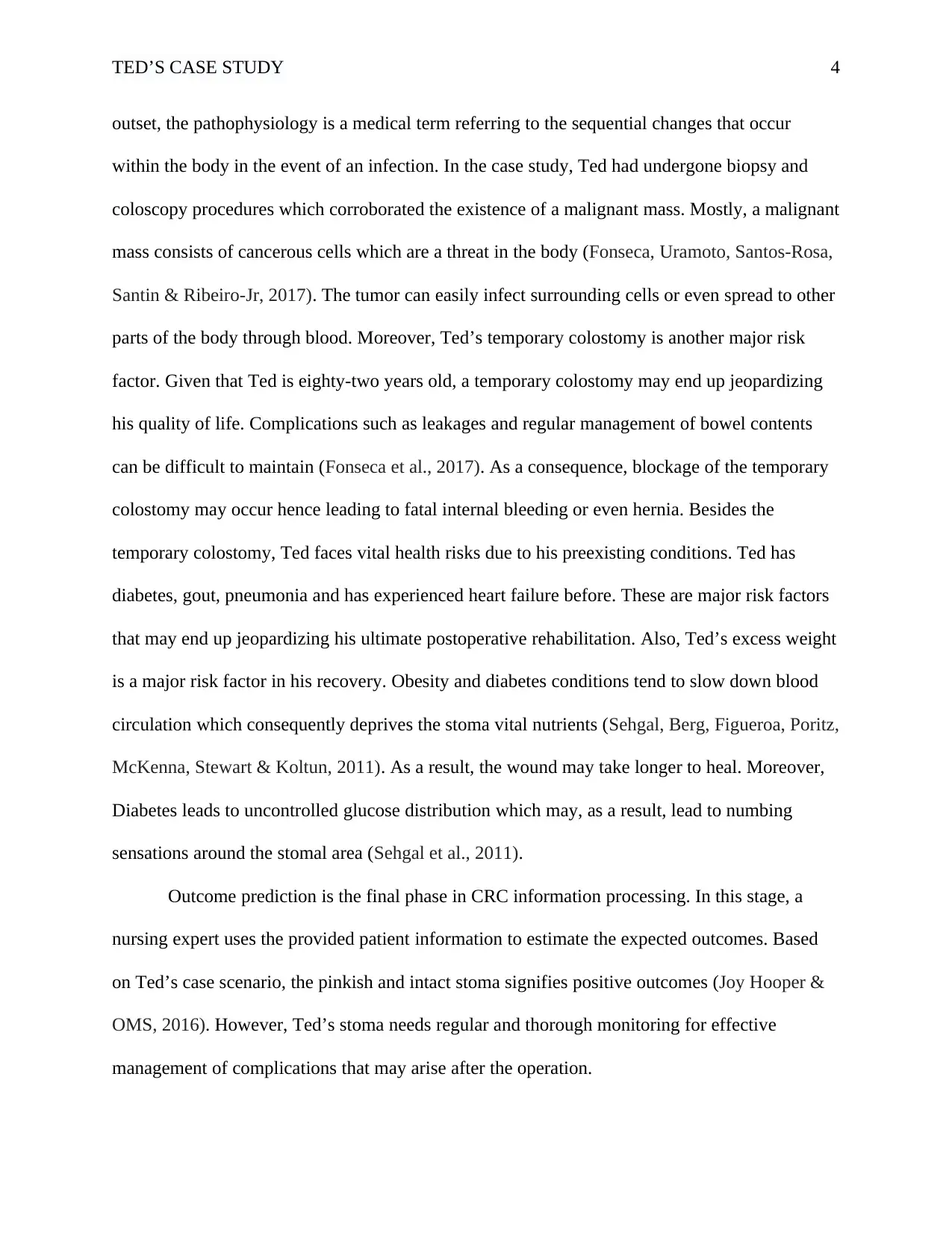
TED’S CASE STUDY
outset, the pathophysiology is a medical term referring to the sequential changes that occur
within the body in the event of an infection. In the case study, Ted had undergone biopsy and
coloscopy procedures which corroborated the existence of a malignant mass. Mostly, a malignant
mass consists of cancerous cells which are a threat in the body (Fonseca, Uramoto, Santos-Rosa,
Santin & Ribeiro-Jr, 2017). The tumor can easily infect surrounding cells or even spread to other
parts of the body through blood. Moreover, Ted’s temporary colostomy is another major risk
factor. Given that Ted is eighty-two years old, a temporary colostomy may end up jeopardizing
his quality of life. Complications such as leakages and regular management of bowel contents
can be difficult to maintain (Fonseca et al., 2017). As a consequence, blockage of the temporary
colostomy may occur hence leading to fatal internal bleeding or even hernia. Besides the
temporary colostomy, Ted faces vital health risks due to his preexisting conditions. Ted has
diabetes, gout, pneumonia and has experienced heart failure before. These are major risk factors
that may end up jeopardizing his ultimate postoperative rehabilitation. Also, Ted’s excess weight
is a major risk factor in his recovery. Obesity and diabetes conditions tend to slow down blood
circulation which consequently deprives the stoma vital nutrients (Sehgal, Berg, Figueroa, Poritz,
McKenna, Stewart & Koltun, 2011). As a result, the wound may take longer to heal. Moreover,
Diabetes leads to uncontrolled glucose distribution which may, as a result, lead to numbing
sensations around the stomal area (Sehgal et al., 2011).
Outcome prediction is the final phase in CRC information processing. In this stage, a
nursing expert uses the provided patient information to estimate the expected outcomes. Based
on Ted’s case scenario, the pinkish and intact stoma signifies positive outcomes (Joy Hooper &
OMS, 2016). However, Ted’s stoma needs regular and thorough monitoring for effective
management of complications that may arise after the operation.
4
outset, the pathophysiology is a medical term referring to the sequential changes that occur
within the body in the event of an infection. In the case study, Ted had undergone biopsy and
coloscopy procedures which corroborated the existence of a malignant mass. Mostly, a malignant
mass consists of cancerous cells which are a threat in the body (Fonseca, Uramoto, Santos-Rosa,
Santin & Ribeiro-Jr, 2017). The tumor can easily infect surrounding cells or even spread to other
parts of the body through blood. Moreover, Ted’s temporary colostomy is another major risk
factor. Given that Ted is eighty-two years old, a temporary colostomy may end up jeopardizing
his quality of life. Complications such as leakages and regular management of bowel contents
can be difficult to maintain (Fonseca et al., 2017). As a consequence, blockage of the temporary
colostomy may occur hence leading to fatal internal bleeding or even hernia. Besides the
temporary colostomy, Ted faces vital health risks due to his preexisting conditions. Ted has
diabetes, gout, pneumonia and has experienced heart failure before. These are major risk factors
that may end up jeopardizing his ultimate postoperative rehabilitation. Also, Ted’s excess weight
is a major risk factor in his recovery. Obesity and diabetes conditions tend to slow down blood
circulation which consequently deprives the stoma vital nutrients (Sehgal, Berg, Figueroa, Poritz,
McKenna, Stewart & Koltun, 2011). As a result, the wound may take longer to heal. Moreover,
Diabetes leads to uncontrolled glucose distribution which may, as a result, lead to numbing
sensations around the stomal area (Sehgal et al., 2011).
Outcome prediction is the final phase in CRC information processing. In this stage, a
nursing expert uses the provided patient information to estimate the expected outcomes. Based
on Ted’s case scenario, the pinkish and intact stoma signifies positive outcomes (Joy Hooper &
OMS, 2016). However, Ted’s stoma needs regular and thorough monitoring for effective
management of complications that may arise after the operation.
4
Paraphrase This Document
Need a fresh take? Get an instant paraphrase of this document with our AI Paraphraser
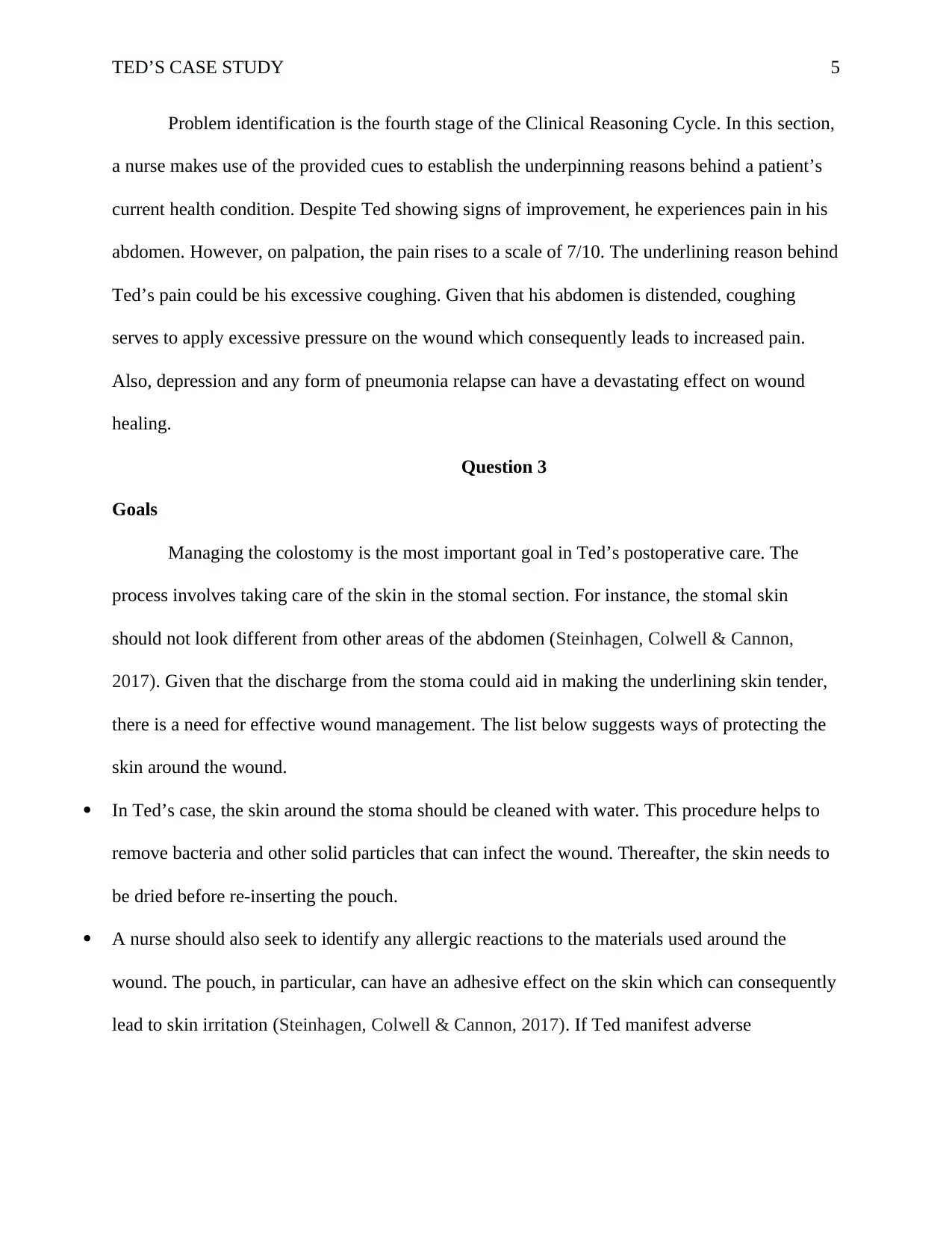
TED’S CASE STUDY
Problem identification is the fourth stage of the Clinical Reasoning Cycle. In this section,
a nurse makes use of the provided cues to establish the underpinning reasons behind a patient’s
current health condition. Despite Ted showing signs of improvement, he experiences pain in his
abdomen. However, on palpation, the pain rises to a scale of 7/10. The underlining reason behind
Ted’s pain could be his excessive coughing. Given that his abdomen is distended, coughing
serves to apply excessive pressure on the wound which consequently leads to increased pain.
Also, depression and any form of pneumonia relapse can have a devastating effect on wound
healing.
Question 3
Goals
Managing the colostomy is the most important goal in Ted’s postoperative care. The
process involves taking care of the skin in the stomal section. For instance, the stomal skin
should not look different from other areas of the abdomen (Steinhagen, Colwell & Cannon,
2017). Given that the discharge from the stoma could aid in making the underlining skin tender,
there is a need for effective wound management. The list below suggests ways of protecting the
skin around the wound.
In Ted’s case, the skin around the stoma should be cleaned with water. This procedure helps to
remove bacteria and other solid particles that can infect the wound. Thereafter, the skin needs to
be dried before re-inserting the pouch.
A nurse should also seek to identify any allergic reactions to the materials used around the
wound. The pouch, in particular, can have an adhesive effect on the skin which can consequently
lead to skin irritation (Steinhagen, Colwell & Cannon, 2017). If Ted manifest adverse
5
Problem identification is the fourth stage of the Clinical Reasoning Cycle. In this section,
a nurse makes use of the provided cues to establish the underpinning reasons behind a patient’s
current health condition. Despite Ted showing signs of improvement, he experiences pain in his
abdomen. However, on palpation, the pain rises to a scale of 7/10. The underlining reason behind
Ted’s pain could be his excessive coughing. Given that his abdomen is distended, coughing
serves to apply excessive pressure on the wound which consequently leads to increased pain.
Also, depression and any form of pneumonia relapse can have a devastating effect on wound
healing.
Question 3
Goals
Managing the colostomy is the most important goal in Ted’s postoperative care. The
process involves taking care of the skin in the stomal section. For instance, the stomal skin
should not look different from other areas of the abdomen (Steinhagen, Colwell & Cannon,
2017). Given that the discharge from the stoma could aid in making the underlining skin tender,
there is a need for effective wound management. The list below suggests ways of protecting the
skin around the wound.
In Ted’s case, the skin around the stoma should be cleaned with water. This procedure helps to
remove bacteria and other solid particles that can infect the wound. Thereafter, the skin needs to
be dried before re-inserting the pouch.
A nurse should also seek to identify any allergic reactions to the materials used around the
wound. The pouch, in particular, can have an adhesive effect on the skin which can consequently
lead to skin irritation (Steinhagen, Colwell & Cannon, 2017). If Ted manifest adverse
5
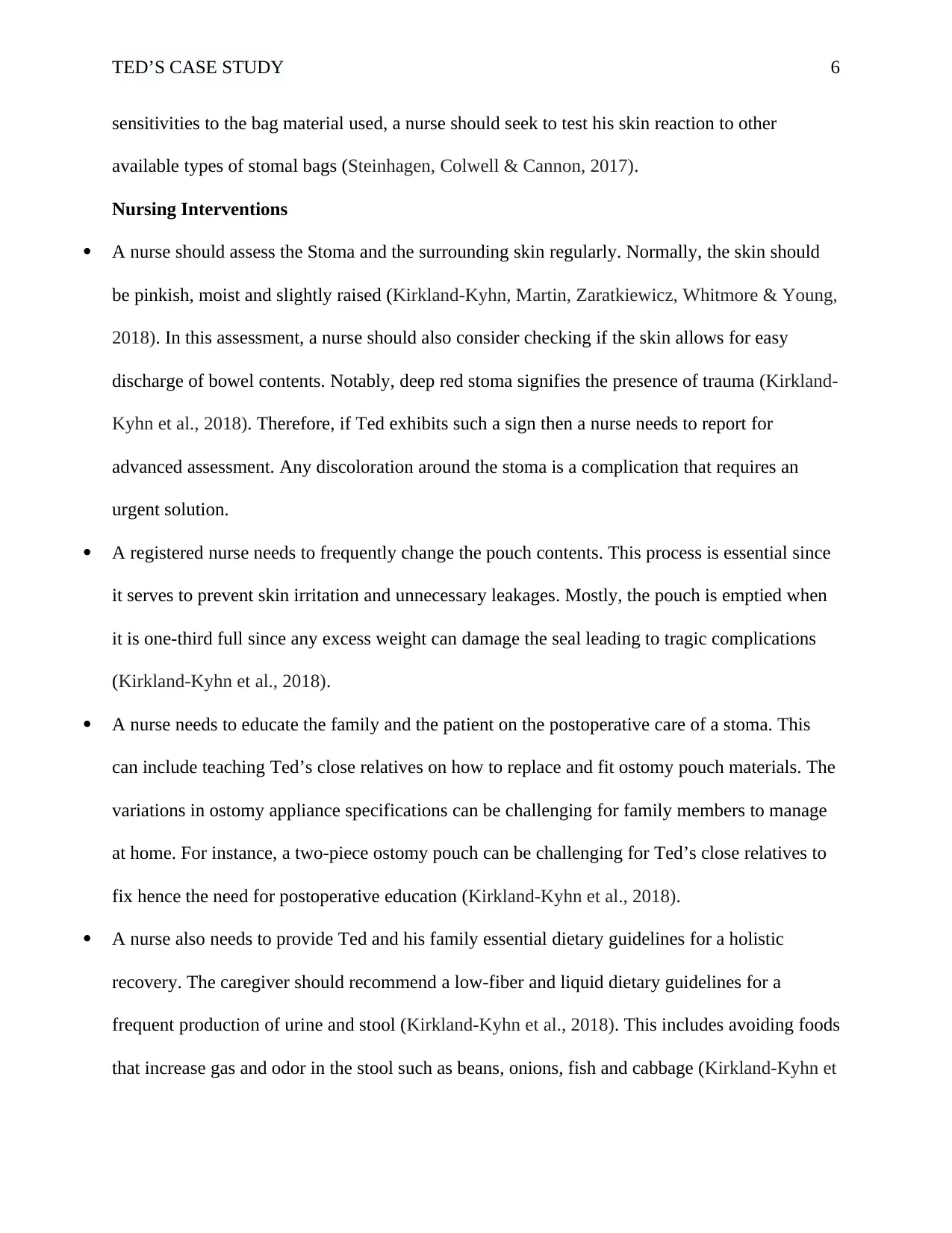
TED’S CASE STUDY
sensitivities to the bag material used, a nurse should seek to test his skin reaction to other
available types of stomal bags (Steinhagen, Colwell & Cannon, 2017).
Nursing Interventions
A nurse should assess the Stoma and the surrounding skin regularly. Normally, the skin should
be pinkish, moist and slightly raised (Kirkland-Kyhn, Martin, Zaratkiewicz, Whitmore & Young,
2018). In this assessment, a nurse should also consider checking if the skin allows for easy
discharge of bowel contents. Notably, deep red stoma signifies the presence of trauma (Kirkland-
Kyhn et al., 2018). Therefore, if Ted exhibits such a sign then a nurse needs to report for
advanced assessment. Any discoloration around the stoma is a complication that requires an
urgent solution.
A registered nurse needs to frequently change the pouch contents. This process is essential since
it serves to prevent skin irritation and unnecessary leakages. Mostly, the pouch is emptied when
it is one-third full since any excess weight can damage the seal leading to tragic complications
(Kirkland-Kyhn et al., 2018).
A nurse needs to educate the family and the patient on the postoperative care of a stoma. This
can include teaching Ted’s close relatives on how to replace and fit ostomy pouch materials. The
variations in ostomy appliance specifications can be challenging for family members to manage
at home. For instance, a two-piece ostomy pouch can be challenging for Ted’s close relatives to
fix hence the need for postoperative education (Kirkland-Kyhn et al., 2018).
A nurse also needs to provide Ted and his family essential dietary guidelines for a holistic
recovery. The caregiver should recommend a low-fiber and liquid dietary guidelines for a
frequent production of urine and stool (Kirkland-Kyhn et al., 2018). This includes avoiding foods
that increase gas and odor in the stool such as beans, onions, fish and cabbage (Kirkland-Kyhn et
6
sensitivities to the bag material used, a nurse should seek to test his skin reaction to other
available types of stomal bags (Steinhagen, Colwell & Cannon, 2017).
Nursing Interventions
A nurse should assess the Stoma and the surrounding skin regularly. Normally, the skin should
be pinkish, moist and slightly raised (Kirkland-Kyhn, Martin, Zaratkiewicz, Whitmore & Young,
2018). In this assessment, a nurse should also consider checking if the skin allows for easy
discharge of bowel contents. Notably, deep red stoma signifies the presence of trauma (Kirkland-
Kyhn et al., 2018). Therefore, if Ted exhibits such a sign then a nurse needs to report for
advanced assessment. Any discoloration around the stoma is a complication that requires an
urgent solution.
A registered nurse needs to frequently change the pouch contents. This process is essential since
it serves to prevent skin irritation and unnecessary leakages. Mostly, the pouch is emptied when
it is one-third full since any excess weight can damage the seal leading to tragic complications
(Kirkland-Kyhn et al., 2018).
A nurse needs to educate the family and the patient on the postoperative care of a stoma. This
can include teaching Ted’s close relatives on how to replace and fit ostomy pouch materials. The
variations in ostomy appliance specifications can be challenging for family members to manage
at home. For instance, a two-piece ostomy pouch can be challenging for Ted’s close relatives to
fix hence the need for postoperative education (Kirkland-Kyhn et al., 2018).
A nurse also needs to provide Ted and his family essential dietary guidelines for a holistic
recovery. The caregiver should recommend a low-fiber and liquid dietary guidelines for a
frequent production of urine and stool (Kirkland-Kyhn et al., 2018). This includes avoiding foods
that increase gas and odor in the stool such as beans, onions, fish and cabbage (Kirkland-Kyhn et
6
⊘ This is a preview!⊘
Do you want full access?
Subscribe today to unlock all pages.

Trusted by 1+ million students worldwide
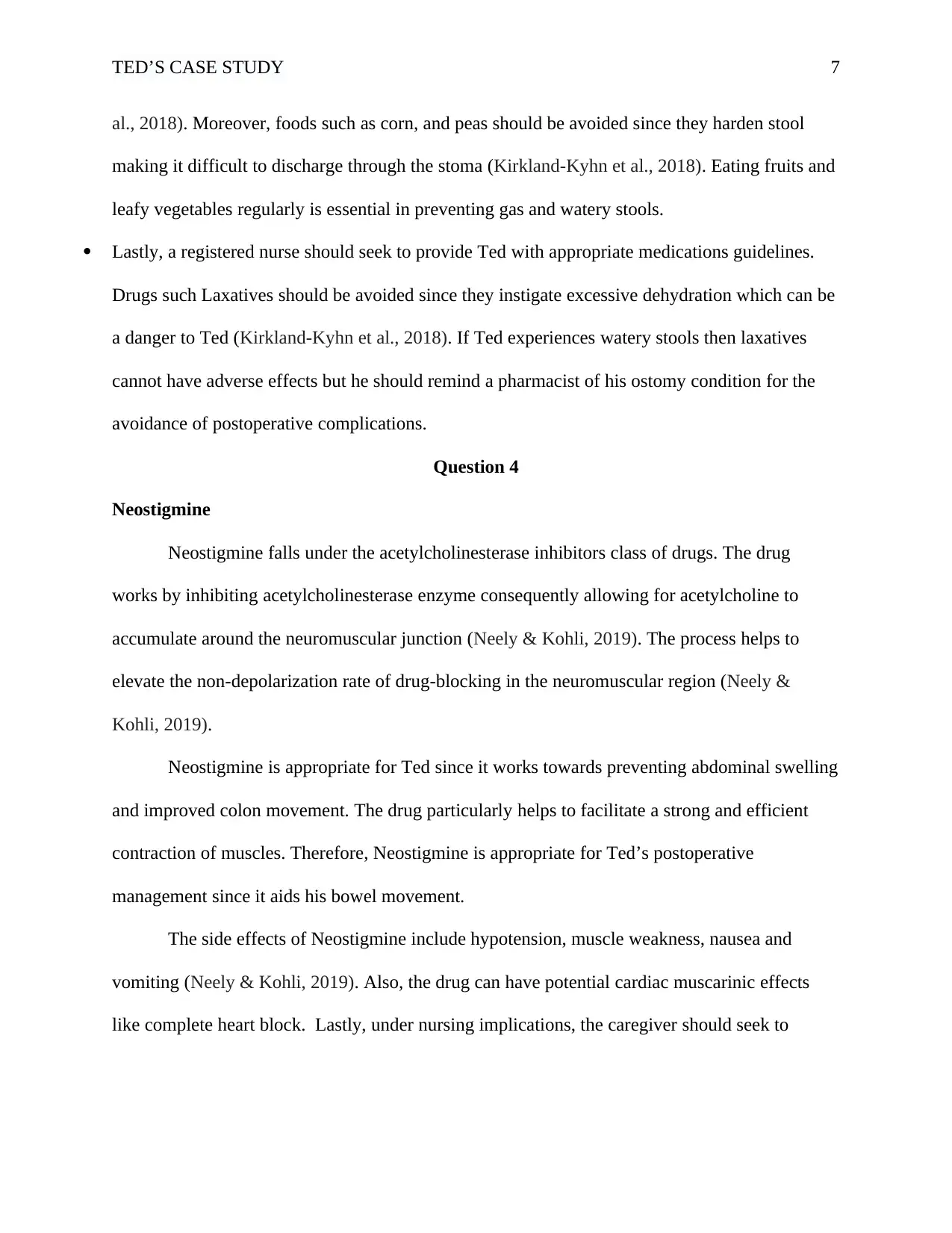
TED’S CASE STUDY
al., 2018). Moreover, foods such as corn, and peas should be avoided since they harden stool
making it difficult to discharge through the stoma (Kirkland-Kyhn et al., 2018). Eating fruits and
leafy vegetables regularly is essential in preventing gas and watery stools.
Lastly, a registered nurse should seek to provide Ted with appropriate medications guidelines.
Drugs such Laxatives should be avoided since they instigate excessive dehydration which can be
a danger to Ted (Kirkland-Kyhn et al., 2018). If Ted experiences watery stools then laxatives
cannot have adverse effects but he should remind a pharmacist of his ostomy condition for the
avoidance of postoperative complications.
Question 4
Neostigmine
Neostigmine falls under the acetylcholinesterase inhibitors class of drugs. The drug
works by inhibiting acetylcholinesterase enzyme consequently allowing for acetylcholine to
accumulate around the neuromuscular junction (Neely & Kohli, 2019). The process helps to
elevate the non-depolarization rate of drug-blocking in the neuromuscular region (Neely &
Kohli, 2019).
Neostigmine is appropriate for Ted since it works towards preventing abdominal swelling
and improved colon movement. The drug particularly helps to facilitate a strong and efficient
contraction of muscles. Therefore, Neostigmine is appropriate for Ted’s postoperative
management since it aids his bowel movement.
The side effects of Neostigmine include hypotension, muscle weakness, nausea and
vomiting (Neely & Kohli, 2019). Also, the drug can have potential cardiac muscarinic effects
like complete heart block. Lastly, under nursing implications, the caregiver should seek to
7
al., 2018). Moreover, foods such as corn, and peas should be avoided since they harden stool
making it difficult to discharge through the stoma (Kirkland-Kyhn et al., 2018). Eating fruits and
leafy vegetables regularly is essential in preventing gas and watery stools.
Lastly, a registered nurse should seek to provide Ted with appropriate medications guidelines.
Drugs such Laxatives should be avoided since they instigate excessive dehydration which can be
a danger to Ted (Kirkland-Kyhn et al., 2018). If Ted experiences watery stools then laxatives
cannot have adverse effects but he should remind a pharmacist of his ostomy condition for the
avoidance of postoperative complications.
Question 4
Neostigmine
Neostigmine falls under the acetylcholinesterase inhibitors class of drugs. The drug
works by inhibiting acetylcholinesterase enzyme consequently allowing for acetylcholine to
accumulate around the neuromuscular junction (Neely & Kohli, 2019). The process helps to
elevate the non-depolarization rate of drug-blocking in the neuromuscular region (Neely &
Kohli, 2019).
Neostigmine is appropriate for Ted since it works towards preventing abdominal swelling
and improved colon movement. The drug particularly helps to facilitate a strong and efficient
contraction of muscles. Therefore, Neostigmine is appropriate for Ted’s postoperative
management since it aids his bowel movement.
The side effects of Neostigmine include hypotension, muscle weakness, nausea and
vomiting (Neely & Kohli, 2019). Also, the drug can have potential cardiac muscarinic effects
like complete heart block. Lastly, under nursing implications, the caregiver should seek to
7
Paraphrase This Document
Need a fresh take? Get an instant paraphrase of this document with our AI Paraphraser
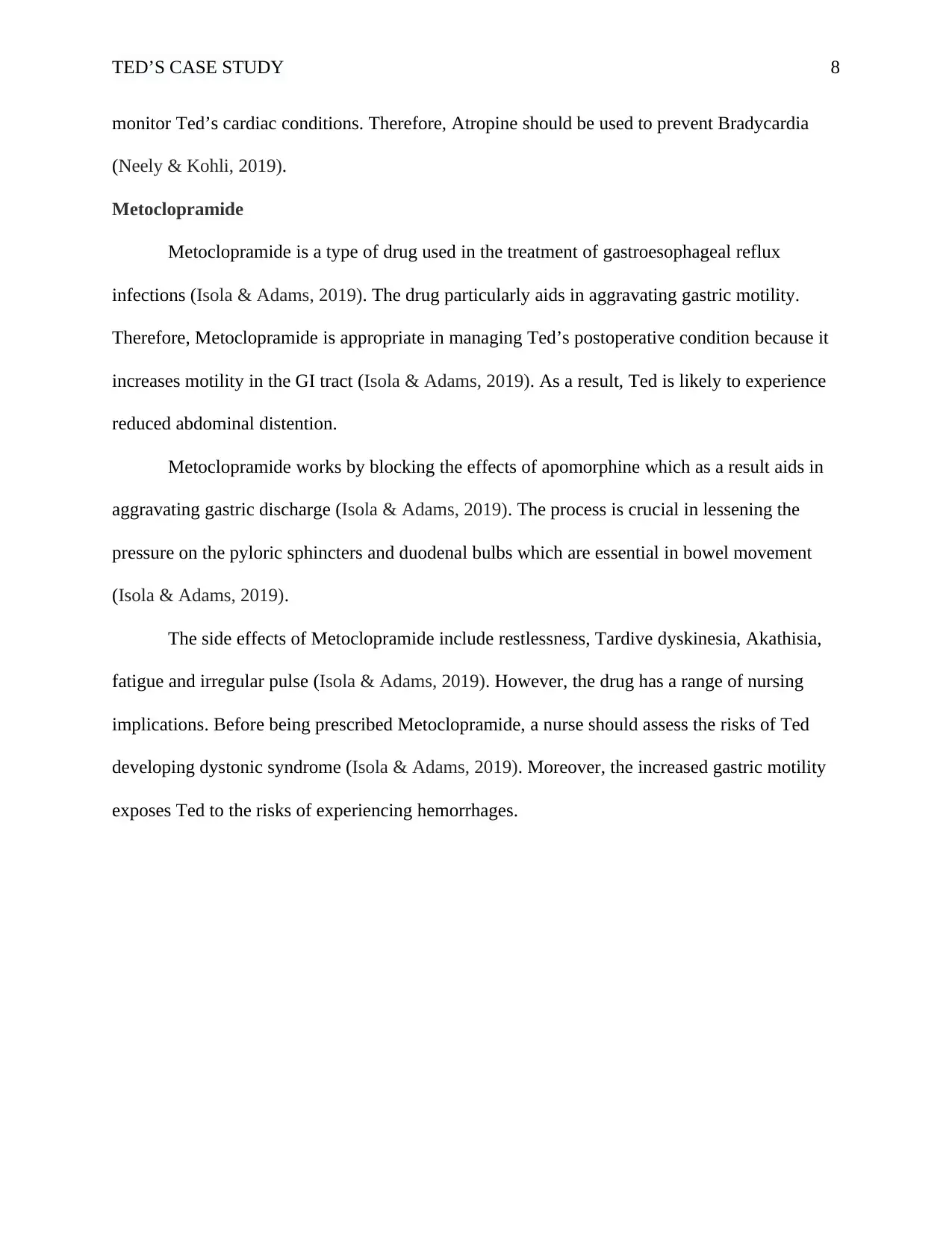
TED’S CASE STUDY
monitor Ted’s cardiac conditions. Therefore, Atropine should be used to prevent Bradycardia
(Neely & Kohli, 2019).
Metoclopramide
Metoclopramide is a type of drug used in the treatment of gastroesophageal reflux
infections (Isola & Adams, 2019). The drug particularly aids in aggravating gastric motility.
Therefore, Metoclopramide is appropriate in managing Ted’s postoperative condition because it
increases motility in the GI tract (Isola & Adams, 2019). As a result, Ted is likely to experience
reduced abdominal distention.
Metoclopramide works by blocking the effects of apomorphine which as a result aids in
aggravating gastric discharge (Isola & Adams, 2019). The process is crucial in lessening the
pressure on the pyloric sphincters and duodenal bulbs which are essential in bowel movement
(Isola & Adams, 2019).
The side effects of Metoclopramide include restlessness, Tardive dyskinesia, Akathisia,
fatigue and irregular pulse (Isola & Adams, 2019). However, the drug has a range of nursing
implications. Before being prescribed Metoclopramide, a nurse should assess the risks of Ted
developing dystonic syndrome (Isola & Adams, 2019). Moreover, the increased gastric motility
exposes Ted to the risks of experiencing hemorrhages.
8
monitor Ted’s cardiac conditions. Therefore, Atropine should be used to prevent Bradycardia
(Neely & Kohli, 2019).
Metoclopramide
Metoclopramide is a type of drug used in the treatment of gastroesophageal reflux
infections (Isola & Adams, 2019). The drug particularly aids in aggravating gastric motility.
Therefore, Metoclopramide is appropriate in managing Ted’s postoperative condition because it
increases motility in the GI tract (Isola & Adams, 2019). As a result, Ted is likely to experience
reduced abdominal distention.
Metoclopramide works by blocking the effects of apomorphine which as a result aids in
aggravating gastric discharge (Isola & Adams, 2019). The process is crucial in lessening the
pressure on the pyloric sphincters and duodenal bulbs which are essential in bowel movement
(Isola & Adams, 2019).
The side effects of Metoclopramide include restlessness, Tardive dyskinesia, Akathisia,
fatigue and irregular pulse (Isola & Adams, 2019). However, the drug has a range of nursing
implications. Before being prescribed Metoclopramide, a nurse should assess the risks of Ted
developing dystonic syndrome (Isola & Adams, 2019). Moreover, the increased gastric motility
exposes Ted to the risks of experiencing hemorrhages.
8
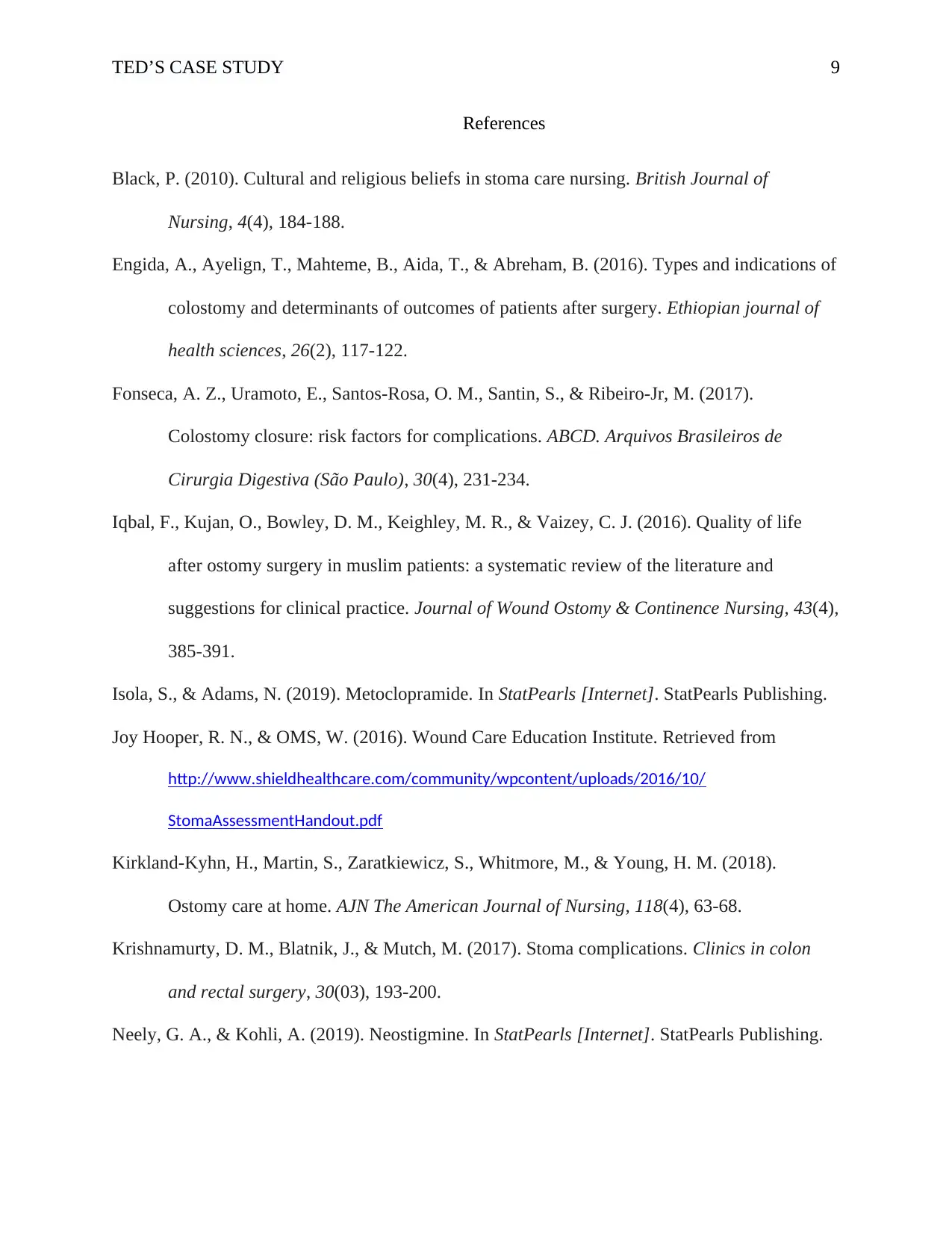
TED’S CASE STUDY
References
Black, P. (2010). Cultural and religious beliefs in stoma care nursing. British Journal of
Nursing, 4(4), 184-188.
Engida, A., Ayelign, T., Mahteme, B., Aida, T., & Abreham, B. (2016). Types and indications of
colostomy and determinants of outcomes of patients after surgery. Ethiopian journal of
health sciences, 26(2), 117-122.
Fonseca, A. Z., Uramoto, E., Santos-Rosa, O. M., Santin, S., & Ribeiro-Jr, M. (2017).
Colostomy closure: risk factors for complications. ABCD. Arquivos Brasileiros de
Cirurgia Digestiva (São Paulo), 30(4), 231-234.
Iqbal, F., Kujan, O., Bowley, D. M., Keighley, M. R., & Vaizey, C. J. (2016). Quality of life
after ostomy surgery in muslim patients: a systematic review of the literature and
suggestions for clinical practice. Journal of Wound Ostomy & Continence Nursing, 43(4),
385-391.
Isola, S., & Adams, N. (2019). Metoclopramide. In StatPearls [Internet]. StatPearls Publishing.
Joy Hooper, R. N., & OMS, W. (2016). Wound Care Education Institute. Retrieved from
http://www.shieldhealthcare.com/community/wpcontent/uploads/2016/10/
StomaAssessmentHandout.pdf
Kirkland-Kyhn, H., Martin, S., Zaratkiewicz, S., Whitmore, M., & Young, H. M. (2018).
Ostomy care at home. AJN The American Journal of Nursing, 118(4), 63-68.
Krishnamurty, D. M., Blatnik, J., & Mutch, M. (2017). Stoma complications. Clinics in colon
and rectal surgery, 30(03), 193-200.
Neely, G. A., & Kohli, A. (2019). Neostigmine. In StatPearls [Internet]. StatPearls Publishing.
9
References
Black, P. (2010). Cultural and religious beliefs in stoma care nursing. British Journal of
Nursing, 4(4), 184-188.
Engida, A., Ayelign, T., Mahteme, B., Aida, T., & Abreham, B. (2016). Types and indications of
colostomy and determinants of outcomes of patients after surgery. Ethiopian journal of
health sciences, 26(2), 117-122.
Fonseca, A. Z., Uramoto, E., Santos-Rosa, O. M., Santin, S., & Ribeiro-Jr, M. (2017).
Colostomy closure: risk factors for complications. ABCD. Arquivos Brasileiros de
Cirurgia Digestiva (São Paulo), 30(4), 231-234.
Iqbal, F., Kujan, O., Bowley, D. M., Keighley, M. R., & Vaizey, C. J. (2016). Quality of life
after ostomy surgery in muslim patients: a systematic review of the literature and
suggestions for clinical practice. Journal of Wound Ostomy & Continence Nursing, 43(4),
385-391.
Isola, S., & Adams, N. (2019). Metoclopramide. In StatPearls [Internet]. StatPearls Publishing.
Joy Hooper, R. N., & OMS, W. (2016). Wound Care Education Institute. Retrieved from
http://www.shieldhealthcare.com/community/wpcontent/uploads/2016/10/
StomaAssessmentHandout.pdf
Kirkland-Kyhn, H., Martin, S., Zaratkiewicz, S., Whitmore, M., & Young, H. M. (2018).
Ostomy care at home. AJN The American Journal of Nursing, 118(4), 63-68.
Krishnamurty, D. M., Blatnik, J., & Mutch, M. (2017). Stoma complications. Clinics in colon
and rectal surgery, 30(03), 193-200.
Neely, G. A., & Kohli, A. (2019). Neostigmine. In StatPearls [Internet]. StatPearls Publishing.
9
⊘ This is a preview!⊘
Do you want full access?
Subscribe today to unlock all pages.

Trusted by 1+ million students worldwide
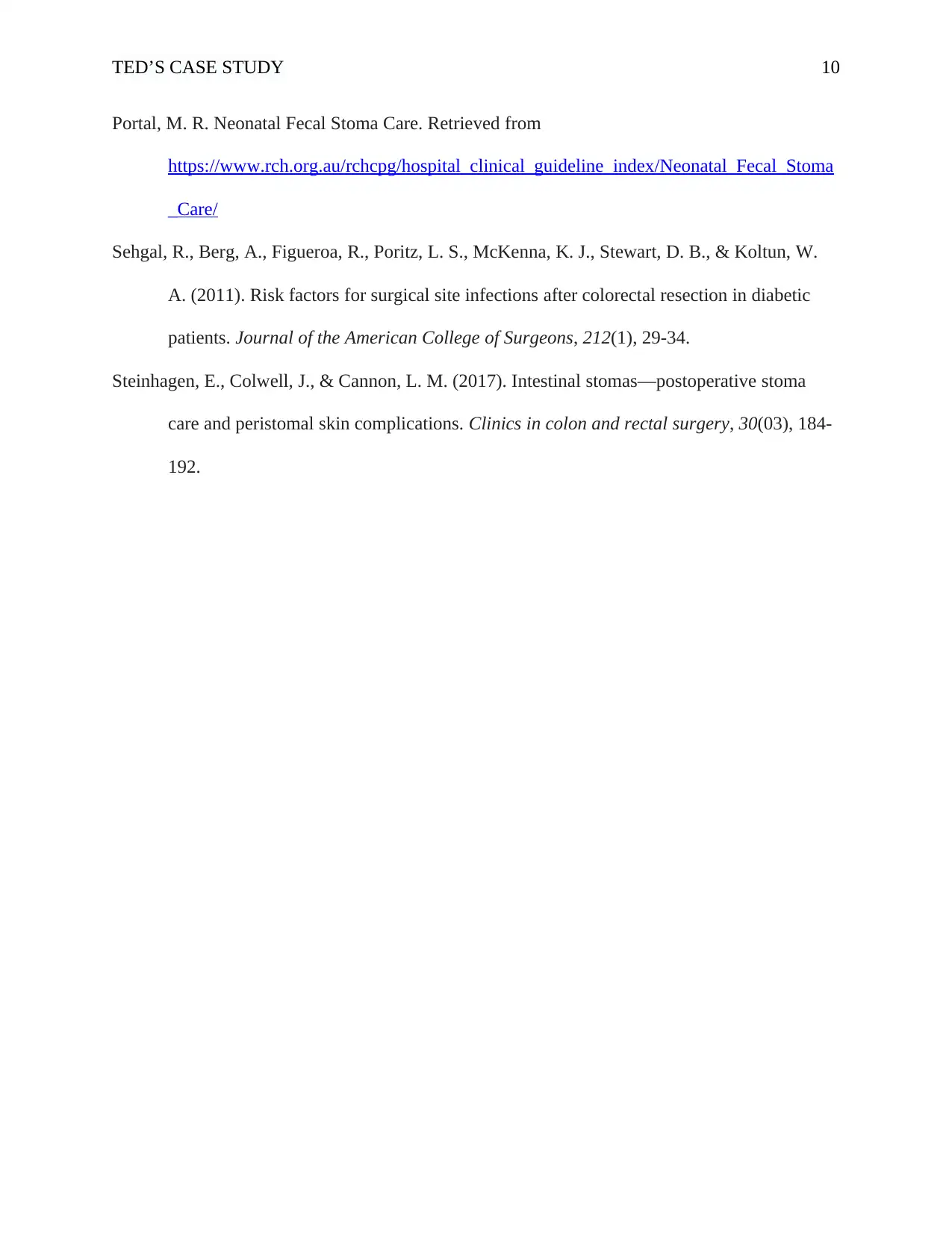
TED’S CASE STUDY
Portal, M. R. Neonatal Fecal Stoma Care. Retrieved from
https://www.rch.org.au/rchcpg/hospital_clinical_guideline_index/Neonatal_Fecal_Stoma
_Care/
Sehgal, R., Berg, A., Figueroa, R., Poritz, L. S., McKenna, K. J., Stewart, D. B., & Koltun, W.
A. (2011). Risk factors for surgical site infections after colorectal resection in diabetic
patients. Journal of the American College of Surgeons, 212(1), 29-34.
Steinhagen, E., Colwell, J., & Cannon, L. M. (2017). Intestinal stomas—postoperative stoma
care and peristomal skin complications. Clinics in colon and rectal surgery, 30(03), 184-
192.
10
Portal, M. R. Neonatal Fecal Stoma Care. Retrieved from
https://www.rch.org.au/rchcpg/hospital_clinical_guideline_index/Neonatal_Fecal_Stoma
_Care/
Sehgal, R., Berg, A., Figueroa, R., Poritz, L. S., McKenna, K. J., Stewart, D. B., & Koltun, W.
A. (2011). Risk factors for surgical site infections after colorectal resection in diabetic
patients. Journal of the American College of Surgeons, 212(1), 29-34.
Steinhagen, E., Colwell, J., & Cannon, L. M. (2017). Intestinal stomas—postoperative stoma
care and peristomal skin complications. Clinics in colon and rectal surgery, 30(03), 184-
192.
10
1 out of 10
Related Documents
Your All-in-One AI-Powered Toolkit for Academic Success.
+13062052269
info@desklib.com
Available 24*7 on WhatsApp / Email
![[object Object]](/_next/static/media/star-bottom.7253800d.svg)
Unlock your academic potential
Copyright © 2020–2025 A2Z Services. All Rights Reserved. Developed and managed by ZUCOL.





